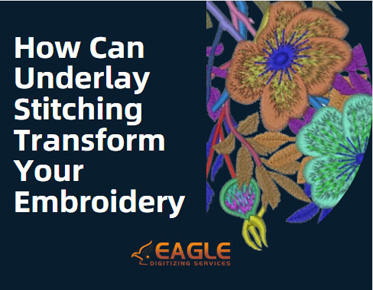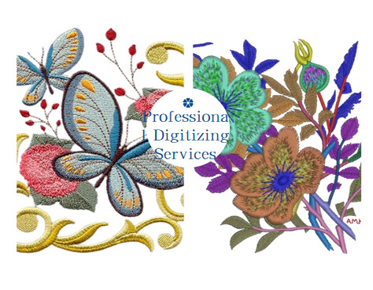How Can Underlay Stitching Transform Your Embroidery?
Embroidery enthusiasts are no strangers to the meticulous craft of underlay stitching for digitizing embroidery. Within the realm of embroidery techniques, underlay stitching stands as a foundational step that often determines the overall quality and longevity of the final embroidered piece. In this article, we delve into the intricacies of underlay stitching, exploring its various techniques, applications, and indispensable tips for achieving impeccable results.
Underlay stitching serves as the foundation of embroidery, providing stability and structure to the design. It involves laying down a base layer of stitches that serves as a support for subsequent layers of stitching. The primary purpose of underlay stitching is to stabilize the fabric, prevent distortion, and enhance the overall quality of the embroidery.
Center
Run
Center run underlay stitching involves stitching along the center of the design area, providing a stable foundation for intricate details and small lettering. This technique is ideal for designs with fine lines and delicate features, as it helps maintain clarity and definition.
Zigzag
Zigzag underlay stitching consists of stitching diagonal lines in a zigzag pattern across the design area. This technique distributes tension evenly, minimizing distortion and puckering in the fabric. It is commonly used for filling large areas and creating texture in the design.
Parallel
Parallel underlay stitching involves stitching parallel lines across the design area, providing additional reinforcement and stability. This technique is suitable for fabrics with stretch or for designs with dense stitching, as it helps prevent distortion and ensures smooth stitching.
Edge
Run
Edge run underlay stitching is performed along the edges of the design area, securing the fabric and preventing fraying. This technique is essential for maintaining the integrity of the design and achieving clean, crisp edges in the finished embroidery.
Fabric
Type and Texture
The choice of underlaystitching technique depends on the fabric type and texture. For delicate fabrics such as silk or satin, a lighter underlay stitching technique may be preferred to avoid distortion. Heavier fabrics like denim or canvas may require a more robust underlay stitching technique for added stability.
Design
Complexity
The complexity of the design also influences the choice of underlay stitching technique. Intricate designs with fine details may benefit from a center run or zigzag underlay stitching to ensure precise stitching and definition. Simpler designs with larger areas of fill may require parallel or edge run underlay stitching for reinforcement and stability.
Thread
Weight and Density
The weight and density of the thread used in the embroidery process affect the effectiveness of the underlay stitching. Heavier threads may require a more substantial underlay stitching technique to support the weight of the stitches and prevent distortion. Lighter threads may necessitate a lighter underlay stitching technique to avoid bulkiness and stiffness in the finished piece.
Embroidery
Machine
An embroidery machine is essential for executing underlay stitching with precision and accuracy. Modern embroidery machines offer programmable settings and advanced stitching capabilities, making them versatile tools for a wide range of embroideryprojects.
Stabilizers
Stabilizers provide support and stability to the fabric during the embroidery process. They come in various types and weights, including tear-away, cut-away, and water-soluble stabilizers, each offering different levels of support and ease of removal.
Threads
Threads play a crucial role in underlay stitching, contributing to the overall aesthetic and durability of the embroidered piece. It is essential to select threads that are compatible with the fabric being used and that complement the design.
Needles
Needles determine the quality of the stitches and the overall success of the embroidery project. Different types and sizes of needles are available for various fabrics and designs, ensuring optimal stitch quality and minimal fabric damage.
Hoops
Hoops are used to hold the fabric taut and secure during the embroidery process, preventing wrinkles, puckering, and shifting. Hoops come in various sizes and styles, each offering different levels of stability and ease of use.
Design
Selection
Choose a design that is suitable for the chosen fabric and intended use of the embroidery. Consider factors such as design complexity, fabric type, and thread weight when selecting a design.
Hooping
the Fabric
Prepare the fabric by hooping it securely in the embroidery hoop. Ensure that the fabric is taut and wrinkle-free to prevent distortion during stitching.
Setting
Up the Machine
Adjust the settings on the embroidery machine according to the chosen design and fabric. This includes selecting the appropriate needle, thread, and stabilizer for the project.
Stitching
the Underlay
Begin the underlay stitching process by stitching the foundation layers of stitches according to the chosen underlay stitching technique. Pay close attention to stitch placement, density, and length to ensure optimal stability and reinforcement.
Adding
Embellishments
Once the underlay stitching is complete, proceed to add embellishments and additional layers of stitching to complete the embroidery design. Experiment with different stitch types, colors, and textures to enhance the visual impact of the design.
Skipping
Underlay Stitching
Skipping underlay stitching can result in unstable and distorted stitches, compromising the integrity of the design and reducing the overall quality of the embroidered piece. It is essential to prioritize underlay stitching as the foundation of embroidery, setting the stage for successful stitching and long-lasting results.
Using
Incorrect Stitching Techniques
Using incorrect stitching techniques can lead to issues such as puckering, thread breakage, and misalignment. It is crucial to select the appropriate underlay stitching technique for the fabric and design, taking into account factors such as fabric type, texture, and weight.
Ignoring
Fabric Tension
Neglecting fabric tension can result in uneven stitches and distortion in the finished embroidery. Ensure that the fabric is hooped securely and that the tension is adjusted properly on the embroidery machine to achieve optimal stitch quality and consistency.
Practice
on Scrap Fabric
Before starting a full-scale embroidery project, practice underlay stitching techniques on scrap fabric to familiarize yourself with the process and refine your skills. This allows you to experiment with different techniques and settings without risking damage to your final project.
Adjusting
Machine Settings
Take the time to adjust the settings on your embroidery machine to achieve optimal results in underlay stitching. This includes selecting the appropriate stitch type, length, and density for the chosen fabric and design. Experiment with different settings to find the perfect balance of stability and flexibility in your stitches.
Experimenting
with Different Stabilizers
Stabilizers play a crucial role in underlay stitching, providing support and stability to the fabric during the embroidery process. Experiment with different types and weights of stabilizers to find the best match for your fabric and design.
Layered
Underlay Stitching
Layered underlay stitching involves stitching multiple layers of underlay stitches in different directions and densities to create dimension and texture in the embroidery design. By varying the placement and density of the stitches, embroiderers can achieve stunning visual effects that enhance the overall impact of the design.
Dimensional
Effects
Dimensional effects can be achieved through careful manipulation of underlay stitches, such as varying the stitch length, density, and direction. By strategically placing underlay stitches in specific areas of the design, embroiderers can create depth and dimension that bring the design to life.
Creating
Texture and Depth
Creating texture and depth in embroidery design can be achieved through a combination of underlay stitching techniques and creative stitching methods. By experimenting with different stitch types, colors, and textures, embroiderers can add depth and dimension to their designs, creating visually striking and tactile pieces that captivate the senses.
Thread
Breakage
Thread breakage is a common issue in underlay stitching, often caused by improper tension or using low-quality thread. To prevent thread breakage, ensure that the tension is adjusted properly on your embroidery machine and use high-quality thread that is compatible with your fabric and design.
Puckering
Puckering can occur when the fabric is not hooped securely or when the tension is too tight on the embroidery machine. To prevent puckering, ensure that the fabric is hooped tautly and that the tension is adjusted properly to allow for smooth stitching without distorting the fabric.
Misalignment
Misalignment can occur when the fabric shifts during the embroidery process, resulting in uneven stitches and distortion in the design. To prevent misalignment, use adhesive or basting spray to secure the fabric in place before hooping, and monitor the stitching process closely to ensure that the fabric remains stable throughout.
In conclusion, underlay stitching is a
fundamental technique in embroidery that plays a crucial role in achieving
professional-quality results. By understanding the different types of underlay
stitching techniques, choosing the right technique for the fabric and design,
and mastering the use of tools and materials, embroiderers can unleash the full
potential of their creativity and achieve stunning embroidery results. With
practice, patience, and attention to detail, mastering underlay stitching opens
up a world of possibilities for creating beautiful and intricate embroidery designs. So, embrace the art of underlay
stitching, experiment with different techniques, and watch as your embroidery
projects come to life with depth, dimension, and stunning visual impact.



